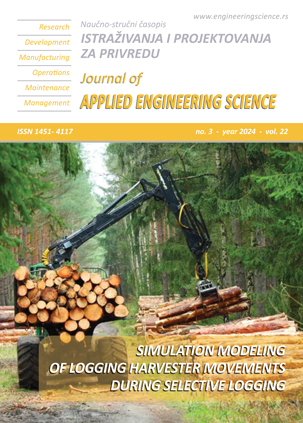MECHANICAL ANALYSIS ON TEST SAMPLES MADE IN CONCRETE REINFORCED WITH STEEL FIBERS
Abstract
Steel fibers have been used for improving the behavior of structural concrete elements for a long time ago. This paper shows the main results from the flexural test of steel fiber reinforced concrete beams, that is to say, flexural strength and toughness. The results were compared with those from the flexural test of reinforced concrete beams with steel bars and plain concrete beams. Steel fiber did not increase the flexural strength and toughness of beams when compare with reinforced beams with steel bars but it does improve the behavior of steel fiber reinforced concrete beams for failure control and gradual mechanics which allows caution about upcoming collapse.
References
Harmsen, T. (2005). Diseño de estructuras de concreto armado. Fondo Editorial Pontificia Universidad Católica de Perú.
Carvalho, E., Ferreira, E., Cunha, J., Rodríguez, C., & Maia, N. (2017). Experimental investigation of steel-concrete bond for thin reinforcing bars. Latin American Journal of Solids and Structures, 14(11), 1932-1951. https://doi.org/10.1590/1679-78254116
Hameed, R., Turatsinze, A., Duprat, F., & Sellier, A. (2009). Metallic fiber reinforced concrete: Effect of fiber aspect ratio on the flexural properties. Journal of Engineering and Applied Sciences, 5(4), 67-72. https://www.semanticscholar.org/paper/METALLIC-FIBER-REINFORCED-CONCRETE%3A-EFFECT-OF-FIBER-Hameed-Turatsinze/ab10a1b64e19e18112ed074acd8febc7578d908e
Li, B., Zhang, W., Xie, H., & Yang, X. (2018). Effects of fiber type, volume fraction, and aspect ratio on the flexural and acoustic emission behaviors of steel fiber reinforced concrete. Construction and Building Materials, 181, 474-486. https://doi.org/10.1016/j.conbuildmat.2018.06.065
Zeybek, Ö., Gül, M., & Koçak, Y. (2022). Performance evaluation of fiber-reinforced concrete produced with steel fibers extracted from waste tire. Frontiers in Materials, 9. https://doi.org/10.3389/fmats.2022.1057128
Anil, N. (2018). Mechanical properties of steel fiber reinforced self-compacting concrete. International Journal of Engineering Technologies, 4, 33-40. https://doi.org/10.19072/ijet.340259
Jabir, H. A., Mohamed, A., & Ali, S. (2020). Experimental tests and reliability analysis of the cracking impact resistance of UHPFRC. Fibers, 8(12), 74. https://doi.org/10.3390/fib8120074
Rashid, K., & Balouch, N. (2017). Influence of steel fibers extracted from waste tires on shear behavior of reinforced concrete beams. Structural Concrete, 18(4), 589-596. https://doi.org/10.1002/suco.201600194
Caggiano, A., Folino, P., Lima, C., Martinelli, E., & Pepe, M. (2017). On the mechanical response of hybrid fiber reinforced concrete with recycled and industrial steel fibers. Construction and Building Materials, 147, 286-295. https://doi.org/10.1016/j.conbuildmat.2017.04.160
Domski, J., Katzer, J., Zakrzewski, M., & Ponikiewski, T. (2017). Comparison of the mechanical characteristics of engineered and waste steel fiber used as reinforcement for concrete. Journal of Cleaner Production, 158, 18-28. https://doi.org/10.1016/j.jclepro.2017.04.165
Hu, H., Papastergiou, P., Angelakopoulos, H., Guadagnini, M., & Pilakoutas, K. (2018). Mechanical properties of SFRC using blended manufactured and recycled tyre steel fibres. Construction and Building Materials, 163, 376-389. https://doi.org/10.1016/j.conbuildmat.2017.12.116
Carrillo, J., Lizarazo-Marriaga, J., & Lamus, F. (2020). Properties of steel fiber reinforced concrete using either industrial or recycled fibers from waste tires. Fibers and Polymers, 21, 2055-2067. https://doi.org/10.1007/s12221-020-1076-1
Simalti, A., & Singh, A. P. (2020). Comparative study on direct shear behavior of manufactured and recycled shredded tyre steel fiber reinforced self-consolidating concrete. Journal of Building Engineering, 29, 101169. https://doi.org/10.1016/j.jobe.2020.101169
Lu, B., Shi, C., Cao, Z., Guo, M., & Zheng, J. (2019). Effect of carbonated coarse recycled concrete aggregate on the properties and microstructure of recycled concrete. Journal of Cleaner Production, 233, 421-428. https://doi.org/10.1016/j.jclepro.2019.05.350
Zhan, B. J., Xuan, D. X., Zeng, W., & Poon, C. S. (2019). Carbonation treatment of recycled concrete aggregate: Effect on transport properties and steel corrosion of recycled aggregate concrete. Cement and Concrete Composites, 104, 103360. https://doi.org/10.1016/j.cemconcomp.2019.103360
Shi, C., Wu, Z., Cao, Z., Ling, T. C., & Zheng, J. (2018). Performance of mortar prepared with recycled concrete aggregate enhanced by CO2 and pozzolan slurry. Cement and Concrete Composites, 86, 130-138. https://doi.org/10.1016/j.cemconcomp.2017.10.013
ASTM International. (2016). ASTM A706/A706M Standard Specification for Deformed and Plain Low-Alloy Steel Bars for Concrete Reinforcement. West Conshohocken, PA.
ASTM International. (2021). Standard test method for compressive strength of cylindrical concrete specimens. West Conshohocken, PA.
ASTM International. (2010). ASTM C1609 Standard Test Method for Flexural Performance of Fiber-Reinforced Concrete (Using Beam with Third-Point Loading).
ASTM International. (2021). ASTM C78/C78M-21 Standard Test Method for Flexural Strength of Concrete (Using Simple Beam with Third-Point Loading). West Conshohocken, PA.
Franco Segura, J. I. (2002). Estructuras de concreto 1. Universidad Nacional de Colombia.
Asociación Colombiana de Ingeniería Sísmica. (2010). Reglamento Colombiano de Construcción Sismo Resistente NSR-10.
Aslani, F., & Nejadi, S. (2012). Bond behavior of reinforcement in conventional and self-compacting concrete. Advances in Structural Engineering, 15(12), 2033-2051. https://doi.org/10.1260/1369-4332.15.12.2033

